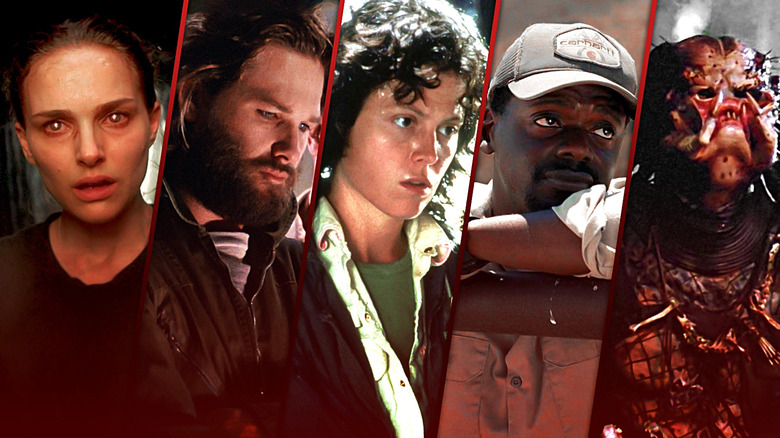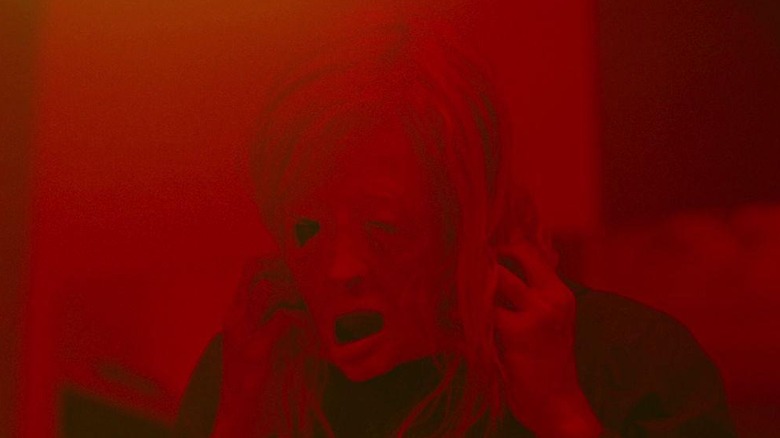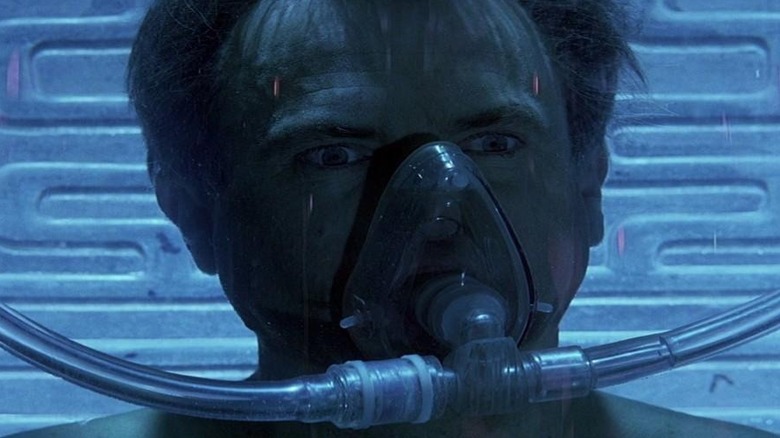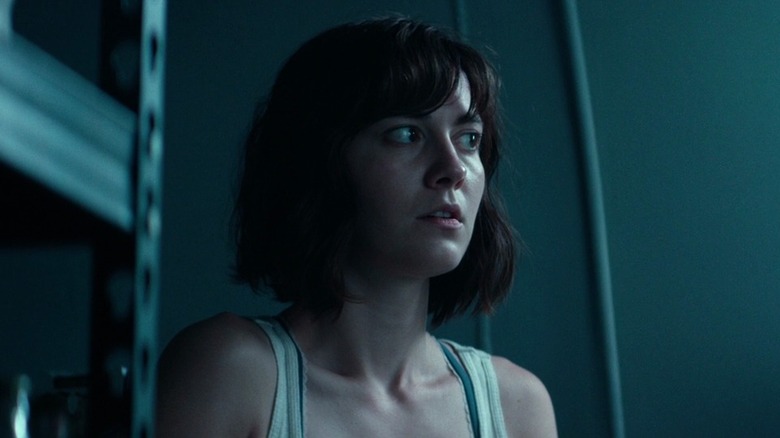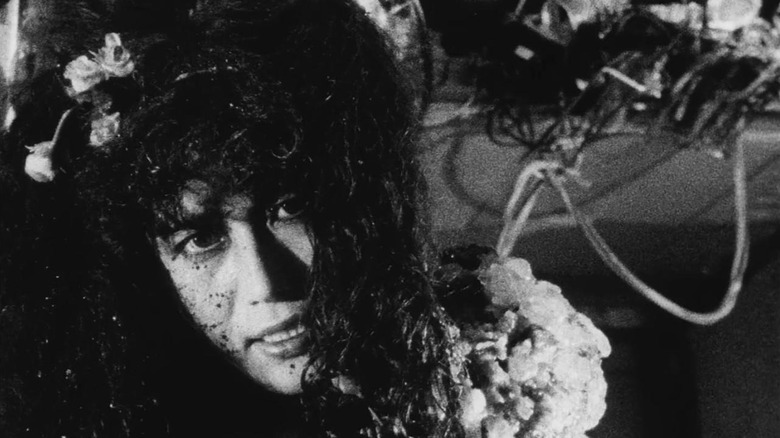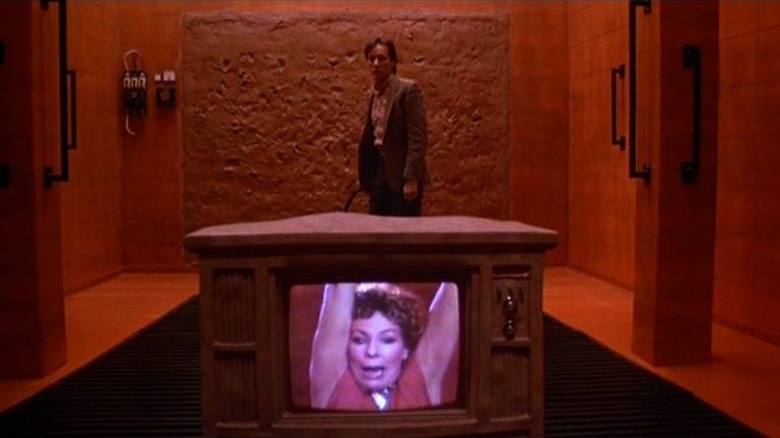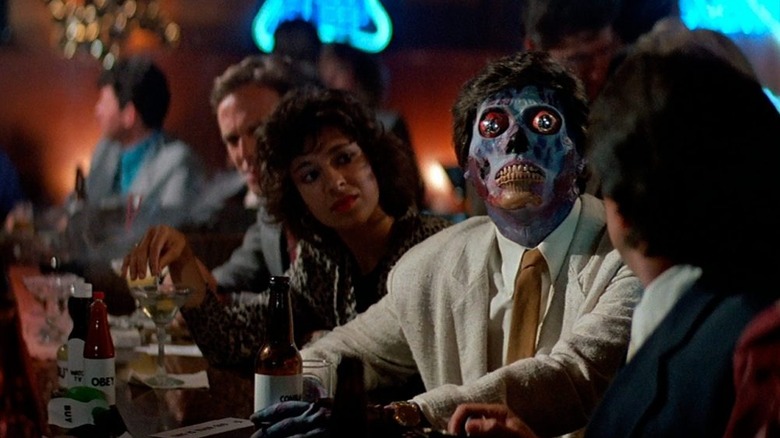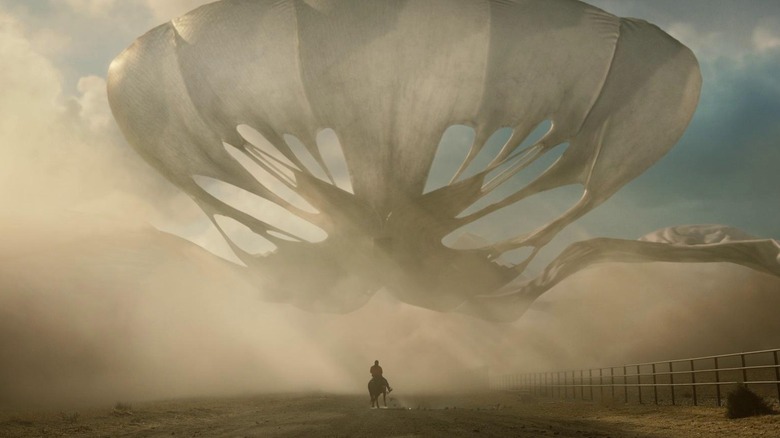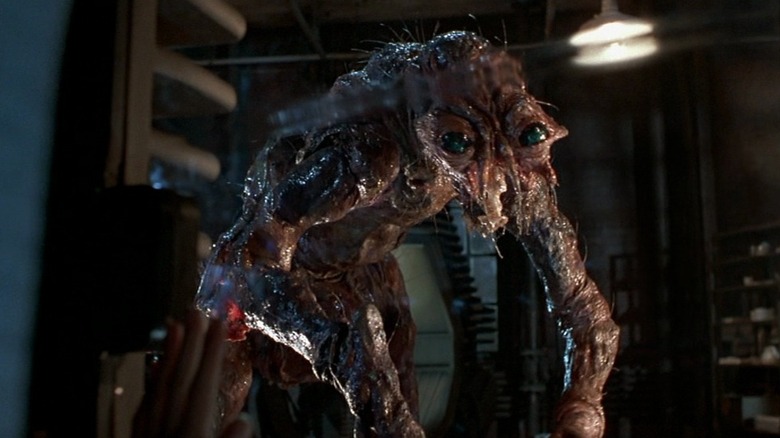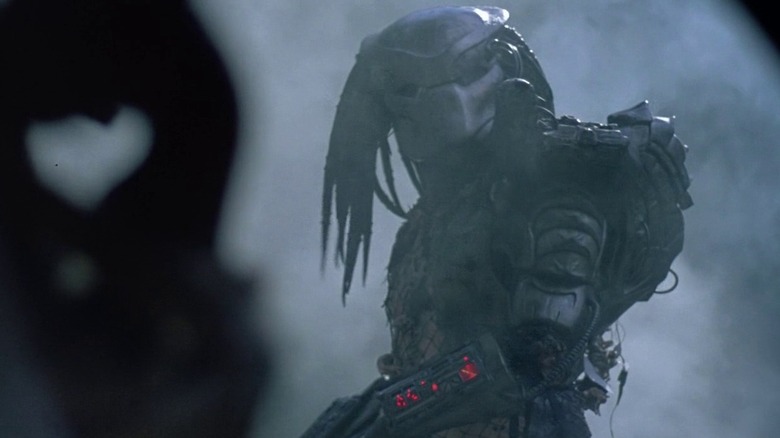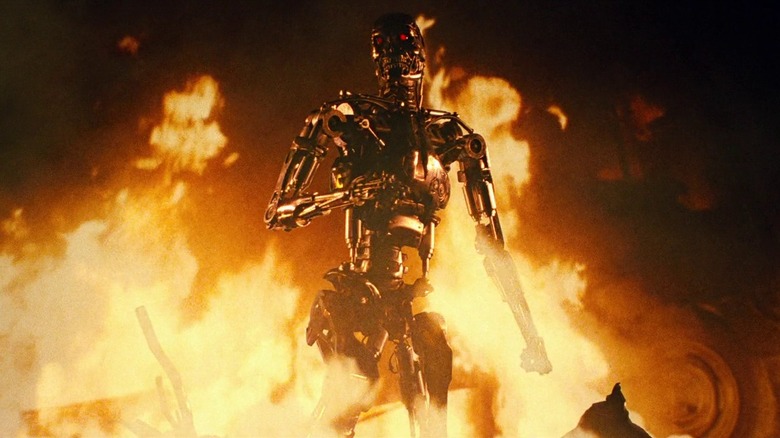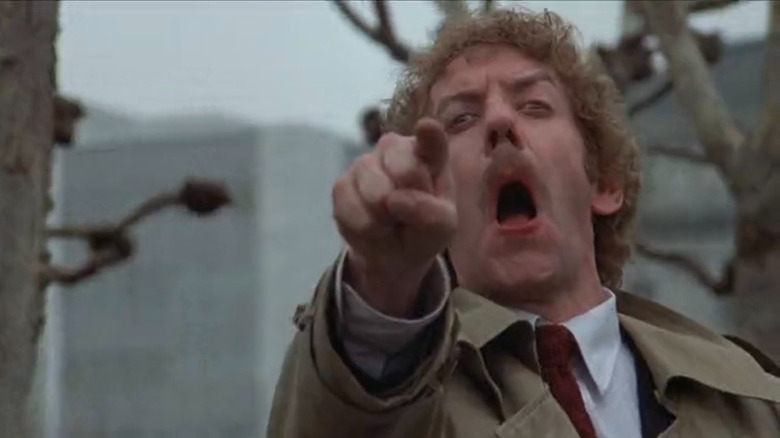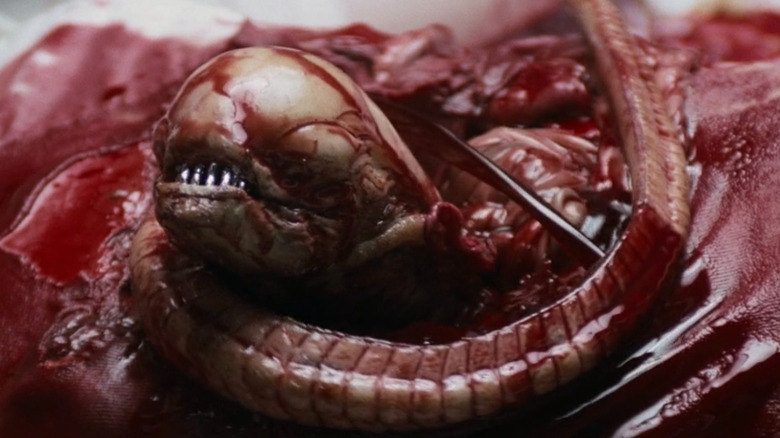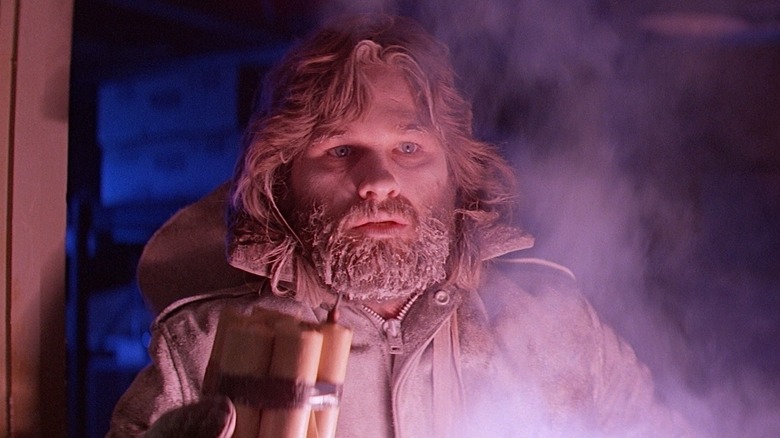15 Best Sci-Fi Horror Movies, Ranked
Science fiction and horror have always felt inextricably linked. This goes back to what many consider the first sci-fi novel ever, Mary Shelley's "Frankenstein," which is also very much a horror tale. It makes sense, as horror often taps into people's deepest fears while sci-fi looks toward the future or envisions a world with a new technology that can be tampered with to devious ends. If horror is fear of the unknown, then science fiction often makes that unknown tangible and forces a story's characters to confront it.
From artificial intelligence to aliens, there are many sci-fi concepts that are ripe ground for terror. On this list of the best sci-fi horror movies of all time, you won't find any ghosts, ghouls, or other things rooted in the supernatural. There has to be an element of science at play, something that makes you watch it and go, "You know, this could be plausible." Ideas surrounding alien life or killer AI robots are all too real because they could actually happen, making these films even scarier than any ghost story.
15. Possessor
We'll get to plenty of David Cronenberg movies later on in this list, but let's kick things off with something from his son, Brandon Cronenberg, who blessed (cursed?) the world with 2020's "Possessor." The film follows an assassin, Tasya Vos (Andrea Riseborough), who carries out her missions by possessing other people's bodies, killing her targets without any of the blame. However, she begins suffering when one host fights back.
Through all this mass death, Tasya also has a hard time maintaining a firm grasp on her own reality. The question of "Who am I?" is integral to countless stories, but it becomes manifest here. Tasya even finds herself saying words and phrases in the mirror as her normal self; it's like she has to pretend to have her own identity because she's so used to assuming other roles through her career.
Cronenberg does an exceptional job building the film's anxious, claustrophobic atmosphere. And like his father before him, Brandon gets a ton of mileage out of the film's disgusting practical effects. Puppets and prosthetics are responsible for the most disgusting "Possessor" moment, which will have you crawling out of your own skin.
14. Event Horizon
The famous tagline for "Alien" was, "In space, no one can hear you scream." But "Event Horizon" feels like it took that concept that amped it up to 11 with a terrifying version of hell that effectively merges science-fiction and fantasy.
When the spaceship Event Horizon re-materializes in the galaxy, a crew is sent to investigate what happened, only to discover the ship's entire crew is dead. As the rescuers search deeper for what happened, they begin experiencing hallucinations, and realize a malevolent force is with them on the ship. The sequence of Captain S.J. Miller (Laurence Fishburne) envisioning hell and the former crew massacring themselves is more than enough to make "Event Horizon" one of the scariest sci-fi movies ever made.
What's most effective about the film is the idea of hell not being a religious realm, but another dimension. It fully leans into the idea of cosmic horror and how there are things out there beyond humanity's comprehension. We're ants in the grand scheme of things, and the crew is powerless against a force they couldn't possibly understand or escape.
13. 10 Cloverfield Lane
"Cloverfield" is a perfectly good found-footage kaiju movie, but the installment in this franchise that's easily the best is the one where we get away from city-wide destruction and primarily focus on a single bunker. Michelle (Mary Elizabeth Winstead) is driving alone when she's in a crash and awakens in a bunker, where she's told by the formidable Howard (John Goodman) that something horrific is going on outside, and they must remain indoors no matter what.
It's a science-fiction film in the loosest sense, since aliens don't show up until the very end (and are more of a fun epilogue rather than vital to the plot). Heck, Winstead didn't even know she was making a "Cloverfield" movie during filming. Instead, the film explores the idea of how some people will use something unexplainable to instill fear in others in order to subjugate them. "10 Cloverfield Lane" is horrifying because the science isn't inherently what's scary; it's that there could be a guy like Howard waiting out there to seize power over anyone weaker than them.
12. Scanners
Leave it to David Cronenberg to make a film that has one of the grossest, most iconic bodily mutilations in film history (the infamous head-exploding scene) while offering commentary on the loss of bodily autonomy in the world of corporate overreach. The film creates a world where some people have developed psychic abilities like telepathy and technopathy, and a company called ConSec wants to round them up to use for their own nefarious purposes.
Cronenberg built his career on body horror, and "Scanners" examines what happens when the body itself becomes a weapon. There's no outside force; the scanners throughout the film are created through pharmaceutical malfeasance. But now they can read anyone's minds, resulting in a lack of privacy and autonomy, or simply kill whoever they want with mere thoughts. Yes, the head-exploding scene is gross, and body horror as a whole is known for its utilization of gore. But on a deeper level, the film examines what happens when your body is no longer yours to own, and what happens when a governmental force ensnares you in its own machinations.
11. Tetsuo: The Iron Man
"Tetsuo: The Iron Man" doesn't have a traditional narrative, but the imagery is more than enough to sear itself into your mind. It's one of the greatest Japanese horror films ever made, as we see a man transform into a mechanical abomination with mechanical parts overtaking his body and giving him violent fantasies toward his girlfriend. It's arguably a film more concerned with instilling a visceral reaction into the viewer than telling a story, but that's part of what's made it a lingering body horror film.
Since the narrative itself is open-ended, people can place their own thematic readings onto it. I'm most interested in the central idea that machines have taken over nature. The film is set in a dystopian Tokyo, and any semblance of humanity quickly gets welded over. It would be a disservice to "Tetsuo" to say it exists solely to shock, but in a world where people seem more than happy to sacrifice parts of what make them human (i.e. using AI to "create" "art" rather than, you know, creating art themselves), it's important to remember that we aren't meant to be machines.
10. Videodrome
"Long live the new flesh."
"Videodrome" manages to be one of David Cronenberg's horniest, most disgusting films, often within the same frame. It sees a UHF station CEO, Max Renn (James Woods), looking for the next big show; he believes it's going to be a series of snuff films that captivate anyone who watches. But the more he tries to locate where the series is taking place, he succumbs to hallucinations and loses his grip on reality.
"Videodrome" foretold the dangers of mass media and people losing the ability to tell what's real and what's fake. It's all the more pertinent today in the social media age where you never know if an influencer is telling you a story that actually happened or is just trying to sell you supplements. Just like Max Renn couldn't tell if his body really fused with a gun, it's slowly becoming harder to tell if a news broadcast is actually just generative AI. In a way, social media is the new flesh as we've all adopted personas to match whatever vibe we want, making "Videodrome" all the more horrific.
9. They Live
Another great sci-fi horror film that feels more at home today than the period it came out is "They Live." John Carpenter's satire sees a drifter (Roddy Piper) uncover a conspiracy that aliens have infiltrated every power structure on Earth and have made humanity mindless consumers while they strip the planet of its resources. When the drifter wears special glasses, he can see the aliens among us, with billboards reading messages like "Obey" and "Buy."
Carpenter wrote "They Live" due to his dissatisfaction with President Ronald Reagan's policies and his disgust that everything in media seemed designed to sell people something. It's an issue that's only grown more prominent in recent years, as you can't scroll on Facebook or Instagram for five seconds without stumbling upon an ad for something you just talked about with your friends. There's no alien invasion taking place; we're all just at the whim of corporate overlords. "They Live" utilizes the concept of an alien invasion to show how unnatural our current way of living is, and far too few people have heeded the message.
8. Annihilation
"Annihilation" may have bombed at the box office, but that doesn't mean it's not worth your time. On the contrary: "Annihilation" is one of the most astounding science-fiction horror films in recent memory. The plot follows a group of scientists who enter an area known as the Shimmer to investigate an otherworldly force mutating plants and animals. This includes one of the freakiest moments I can recall, where what remains of the group hide from a mutated bear that is calling out using their dead friend's voice.
What makes "Annihilation" fascinating to watch and rewatch is how it isn't a typical alien invasion film. The Shimmer has existed for years, and they're trying to figure out what exactly is going on. Even by the movie's end, we don't have much in the way of definitive answers, allowing the audience to fill in the blanks. It's the true definition of cosmic horror; aliens aren't little gray men we can comprehend. Their visages and what they bring with them could be completely unfathomable to our minds, which can be simultaneously beautiful and dreadful.
7. Nope
Jordan Peele burst onto the horror scene with 2017's "Get Out," and from there, he's only grown bolder with each subsequent film, with "Nope" arguably being his most fascinating to date. It sees a pair of siblings, OJ (Daniel Kaluuya) and Em (Keke Palmer), trying to reign in an extraterrestrial being. And then there's the storyline of Jupe (Steven Yeun), who exploits the trauma of surviving an ape attack as a child actor and entices people from all over to get a good look at a creature called Jean Jacket, resulting in the most disturbing sequence of "Nope" by far (and that's really saying something with Gordy).
"Nope" is interested in the idea of the spectacle of tragedy. Jupe profits off his haunting past. Em wants to get video of the creature, believing it could benefit the family financially. But there are some things we shouldn't mess with, whether it's something that's close to us evolutionarily as a chimpanzee or something as strange and Lovecraftian as Jean Jacket.
6. The Fly (1986)
Remakes tend to get a bad rap, but one of the best ways to remake a movie is when you know you can enhance the original through more advanced special effects. 1958's "The Fly" is a solid B-movie, but the fly monster is still just a guy wearing a fly mask. For his 1986 film "The Fly," David Cronenberg took the final beast into far more disgusting territory, with the most memorable aspect being the final manifestation of Seth Brundle's (Jeff Goldblum) hubris after an experiment goes wrong, and he transforms into a hideous part-fly, part-man creature.
As with much of Cronenberg's work, there's the central idea that one of the most horrifying possibilities to befall a person is existing inside a body that is no longer their own. That's what makes Seth's final plan — merging himself with Ronnie (Geena Davis) and their unborn child — so terrifying. Obtaining the fetus is a desperate bid to maintain some semblance of humanity, but even before he goes full Brundlefly, you can see how his humanity is already lost.
5. Predator
The original "Predator" remains a fascinating addition to sci-fi horror canon because at its core, it's really just a slasher movie. The central Yautja is effectively just Jason Voorhees, except instead of killing camp counselors, he's killing buff commandos. Naturally, Arnold Schwarzenegger's character is the "final girl" who realizes that the best way to defeat this combatant isn't with hand-to-hand combat, but by outsmarting it.
The Yautja design remains incredible to this day, but what makes "Predator" amazing to rewatch is how it opens like a regular action movie. You think you're about to follow Schwarzenegger and Carl Weathers into the jungle for some awesome action scenes. In reality, they discover they're far too out of their depth. And unlike other slashers like Jason, it is actually possible to kill one for good without needing a supernatural explanation for how it keeps coming back. There's an entire alien race of Predators who seem to love coming to Earth to hunt humans, but you'll never forget your first time.
4. The Terminator
"Terminator 2: Judgment Day" is rightfully considered the best film in that franchise, but the original 1984 flick is pretty great, too, and it falls more into the sci-fi horror camp as opposed to "T2," which feels far more action-y. "The Terminator" sees the titular killer robot, played by Arnold Schwarzenegger, travel back in time to kill Sarah Connor (Linda Hamilton), which would prevent her son from ever being born and leading a revolution against Skynet.
AI is a great antagonist to use in sci-fi horror because it comes from humanity's own doing. We invented something smarter than ourselves, and we pay the price. "The Terminator," like "Predator," is basically a slasher movie from the perspective of Sarah, and the Terminator is more than willing to mow down anyone who gets in its way. The film's embrace of horror tropes with a sci-fi mentality make it a foreboding vision of what could happen if ChatGPT ever decides to stop just spewing out incorrect information and tries to take over the globe.
3. Invasion of the Body Snatchers (1978)
"Invasion of the Body Snatchers" continues to be one of the most powerful allegories for how materialism has taken over our everyday lives. In the 1978 film, Matthew (Donald Sutherland) and Elizabeth (Brooke Adams) uncover how people have been replaced with pod creatures, who are identical to their hosts in every way except for the lack of humanity. However, as one pod person tells them, "Nothing changes: You have the same life, the same clothes, the same car." It's as though having the same stuff equates to leading a full life as opposed to being able to love and care.
The movie features an incredible slow build. There's the constant paranoia that someone could've already turned into a parasitic alien, and there'd be no way to tell. Getting replaced with an alien may rid you of anxiety and fear, but part of being human means feeling negative emotions sometimes. And given the nature of the aliens, "Invasion of the Body Snatchers" remains one of the few horror films that would be near-impossible to escape from.
2. Alien
Aliens make up a good portion of the best sci-fi horror movies of all time, but few movies have told extra-terrestrial-centric horror stories as brilliantly and concisely as 1979's "Alien." The movie has all the features of a standard haunted house pic, but instead of evil spirits, a group of space truckers are stuck in the cosmos with a Xenomorph. In a single film, the audience understands this creature's life cycle, seeing every facet that makes it a formidable foe whether it embeds a chestburster within a host or scalds you with its acid blood.
The Xenomorph's design is, appropriately, the stuff of nightmares. But what takes "Alien" to the next level is the complete disregard for human life. The company the truckers work for, Weyland-Yutani, is fine with all of them dying, provided the Xenomorph makes it back to Earth all right. The crew members are hopelessly out of their depth against both a monstrosity and the whims of capitalism. It's a lean horror movie, and while the sequels have been hit and miss, they've found some pretty ingenuous ways to expand upon the lore.
1. The Thing (1982)
It's difficult for film to adapt one of the central tenets of cosmic horror: the idea that there are things beyond our comprehension. For a visual medium, we need to see the monstrosity somehow, and no film manages this as well as 1982's "The Thing." The film is set at a remote research lab infiltrated by an alien that can look like anyone or anything. There's no true form to the creature; sometimes it looks like a spider demon and other times it looks like a dog or a human. Given that, there's not just one monster to fear but many, and that growing distrust and paranoia among the researchers make "The Thing" all the more relevant today.
It's interesting to see how so many of the best sci-fi horror movies deal with paranoia and the idea that the enemy can look like a normal person. Having aliens blow up cities is definitely scary, but there's something to be said of the more psychological horror that arises when you can't tell what's alien and what's human.
"The Thing" wasn't a hit when it first came out, but it's gone on to become a pinnacle of its genre(s). Sometimes, the world just needs time to recognize the impact of a stellar piece of art, and "The Thing" manages to scare while provoking thoughts about the nature of humanity and how, when push comes to shove, we have a tendency to turn on one another.
